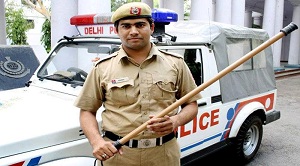Soon, Delhi cops will get protective gear and equipment in line with their counterparts from the US and European countries. Police Commissioner Amulya Patnaik has finalised a plan to procure a range of items like fibreglass helmets, polycarbonate shields and batons for his men. Apart from these, the city policemen will get utility belts, which will help them carry handcuffs, radio sets, magazines, among others, easily. A total of 10,000 such belts will be procured.
The department is procuring 7,135 body protectors, 5,717 helmets, 5,274 body shields and 10,500 polycarbonate lathis. Special commissioner Dependra Pathak confirmed the development. These will protect cops not only from stone pelting, but also from cane and knife attacks. They will also help them dodge projectiles during riots, say cops. The body protectors, weighing around 3 kg each, will have jackets made of fine-quality fire retardant cloth in khaki and olive green with camouflage patterns. They will have front and back pouches with trauma pads.
The polycarbonate lathis will be 910 mm long, 3mm thick and 620mm (concave) wide. These are durable, lightweight and cause less harm to an individual. The list also includes around 51,000 pairs of sports shoes, which will be procured over three years.
In the West, a policeman usually wears a bulletproof vest and a duty belt. The latter is used to carry a Taser, a wireless set, two pairs of handcuffs, a flashlight, a baton, a Glock 22 pistol with ammunitions and an extra back-up weapon. In western countries, a cop’s full gear costs anything between $5,000 and $6,000 and weighs around 13kg. The full attire of a Delhi policeman will cost Rs 1-2 lakh, excluding the Glock pistol.
The move to equip the cops with advanced gear comes in the wake of speculations that Delhi Police may soon be segregated into two wings: law and order and investigation. Each wing may be headed by a special commissioner with the commissioner being the overall head. The law and order may continue to have two divisions—north and south.








